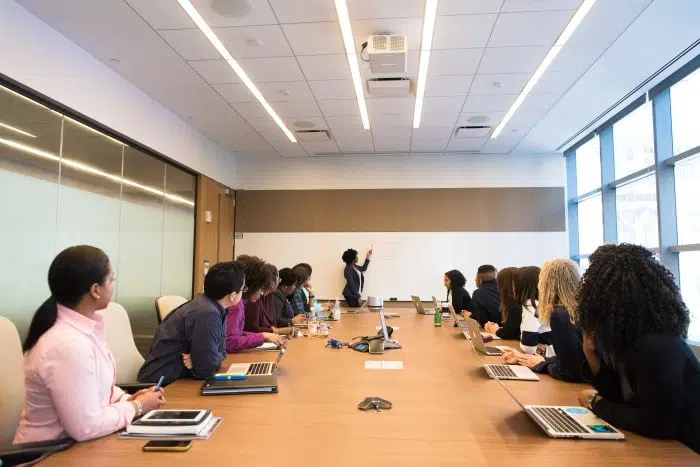Table of Contents
Reimagining the Essence: Embracing the Importance of Meetings
It’s time to shed the negative associations and rediscover the true significance of meetings. Instead of groans and eye rolls, let’s foster a culture that recognizes the importance of these gatherings. Meetings become dynamic platforms for collaboration, inspiration, and productivity. They fuel creativity, spark innovation, and propel teams towards success. By embracing the essence of meetings, we unlock a world of possibilities where engagement and purposeful interaction thrive. Let’s banish the tedium, harness the power of collective wisdom, and make every meeting a catalyst for growth and achievement. Together, we redefine the importance of meetings and drive organizations towards greatness.
What Is a Meeting, Anyway?
In the corporate culture, meetings are your organization’s method of putting most, if not all, of the employees in one room. It can be done to make announcements, recognize a job well done, let everyone know of changes, or discuss plans and operational strategies. A meeting is conducted when you have two or more participants in the same room (or virtually) sharing a discussion relevant to the organization.
Are Meetings Essential?
Yes, meetings are a fundamental part of doing business because this is the perfect avenue to communicate with each member of the organization openly. Organizations without meetings are often faced with nasty problems in miscommunication, lack of direction, and accountability – all that could have been easily solved by having a central communication event.
Meetings become the ideal platform to discuss issues affecting everyone openly. It is an excellent avenue to disseminate information and remind everyone of the goal of the organization. Without this constant communication thread, it is so easy for any organization to lose sight of its goals.
Meetings are also an essential tool to collectively share ideas for an organization’s growth and discuss problems and potential solutions.
An ideal meeting should leave employees motivated and supported, knowing that the much-needed guidance is on standby. It should leave people feeling secure and appreciated in their jobs, and meetings should make everybody think they are in the right place.
The importance of meetings in business communication can’t be highlighted enough, and if done right, you can create a work environment built on open communication, teamwork, and trust.
The Importance of Physical Meetings: Reigniting Connection and Collaboration Post-COVID-19
During the global pandemic, many of us experienced a profound sense of social isolation. We longed for the familiar hangout spots and the presence of friends we had to keep at a distance. While remote work allowed us to adapt, it also left a void in our ability to socialize, even within the confines of our workplaces.
As we move towards the end of COVID-19, businesses should seize the opportunity to reestablish an often-overlooked system of informal exchanges that were once commonplace during coffee or smoke breaks. These conversations, albeit returning slowly, provide a chance to reconnect with our coworkers and engage in stress-free discussions about work.
Renowned author Roxane Gay captured the essence of this camaraderie in her article for the New York Times in March 2021. She aptly expressed, “For all the faults of the workplace, there is a certain camaraderie that comes with life in an office. A good meeting can be energizing in a way that is hard to replicate over Zoom. We can’t head over to our favorite work friend’s office for some coffee and gossip when we need a break. It’s all Slack chats and emails and phone calls and then whatever happens at home after work, without any distance. The work-life balance has imploded for better and worse.”
The gradual return to physical offices presents a golden opportunity for businesses and their employees alike. It allows for the revival of face-to-face interactions that foster a sense of community and collaboration, something that virtual meetings struggle to replicate. Physical meetings provide a unique environment for genuine connections to form, ideas to flow seamlessly, and creativity to flourish.
In these meetings, employees can engage in spontaneous conversations, build trust, and cultivate relationships that extend beyond work tasks. The organic exchanges during coffee breaks or water cooler chats are invaluable for building a cohesive and supportive team. By encouraging these interactions, managers can create an environment where individuals feel valued, heard, and connected to their colleagues.
Moreover, physical meetings offer a break from the monotony of virtual communication and screen fatigue. They provide a change of scenery, allowing employees to step away from their desks and experience a new environment conducive to fresh perspectives and renewed energy. Face-to-face interactions enable nonverbal cues, such as body language and facial expressions, to enhance communication and understanding, ultimately leading to more effective collaboration and problem-solving.
Harnessing the Power of Combined Physical and Virtual Meetings: Maximizing Benefits for Workers and Companies
The value of remote work has become increasingly evident during the global pandemic. However, in the current landscape, it is crucial for managers to recognize the importance of both effective physical and virtual meetings. These meetings serve as catalysts for productivity, team cohesion, and employee well-being, providing a platform for individuals to express thoughts, contribute ideas, and receive immediate feedback, fostering empowerment and engagement.
The return to face-to-face interactions presents a unique opportunity to reignite the human connection that fuels innovation and success within organizations. Physical meetings allow for genuine, in-person interactions that build trust, strengthen relationships, and promote a sense of camaraderie. The energy and synergy generated in face-to-face settings are unparalleled, creating an environment where ideas can flourish and collaboration can thrive.
Simultaneously, virtual meetings have proven their worth in facilitating communication and collaboration across distances. They provide flexibility, allowing teams to connect regardless of geographical constraints. Virtual meetings enable employees to work remotely while maintaining a sense of belonging and inclusion within the organization. They promote efficiency and time management, eliminating the need for travel and reducing associated costs.
By embracing a combination of physical and virtual meetings, businesses can create a work culture that maximizes the benefits for workers and the company as a whole. Physical meetings offer opportunities for in-depth discussions, brainstorming sessions, and team-building activities that foster a strong sense of unity. These face-to-face interactions cultivate trust, enhance creativity, and generate a shared vision among team members.
On the other hand, virtual meetings offer convenience, efficiency, and inclusivity. They ensure that remote workers can actively participate, contribute their unique perspectives, and stay connected to their colleagues. Virtual meetings also provide a platform for global collaboration, breaking down barriers and facilitating the exchange of ideas on a larger scale. And to put it simply: They accelerate processes within the company!
Advantages of Meetings
Regularly conducting these gatherings have considerable advantages for your organization.
If you are still wondering why meetings are so important as a form of communication, then these are the positives that you get from it:
- It gives the organization’s leaders the setting to share and remind the missions and goals of the business.
- Fosters open communication among everyone
- Encourages everyone to contribute to meetings in a business environment
- Let everyone become involved and heard
- Come up with creative and collaborative solutions
- Opportunity to discover new skills, talents, and resources
Components of an Ideal, Productive, and Anticipated Meeting
Sad to say, however, this is not the case for most organizations. Meetings become stressful because anyone can be placed on the spot. No one is looking forward to it because it can quickly devolve into a fault-finding session, and by the end of it, nobody’s happy.
Stop fretting and take action! Make changes in how you conduct your meetings by following these steps. Rest assured; you will have a forum where everyone is engaged and happy while surprisingly accomplishing many things.
Send a Calendar Invite Several Days Before the Meeting
Unless it is an emergency meeting, give your employees the courtesy and time to shift their tasks and deliverables. Attending meetings is not an excuse for them not to complete their deliverables, so give them enough notice that you will request their time on this schedule. Some would probably do extra work today or come in half an hour earlier tomorrow to accommodate the meeting.
One of the biggest issues with meetings is that they are intrusive into an employee’s work schedule – keeping them in advance helps your workforce stay focused and undisrupted.
Create a Well-Organized Agenda
Never call for a meeting if you don’t have a structured plan. And the need of a meeting should be understood by everyone – not just you but everyone who is invited to attend.
And the best agenda tool that can help you with this is AgreeDo.
AgreeDo can create and manage your agenda. Share your agenda with your participants beforehand, so they know what the purpose of a business meeting is, they know what to expect, and they can even prepare some data for those ‘just-in-case’ moments.
With this web application, your teams will have the ability to suggest topics to review or comment on the agenda items. You can view their comments and make the appropriate adjustments to the agenda all in one place.
Sharing the agenda beforehand is a great way to get your participants’ buy-in on your planned discussion topics.
Run Your Meeting as Scheduled
Follow the agenda; take notes of action items, responsibilities, assignments, and decisions. And with AgreeDo, you can do all this simultaneously.
Make sure you open the floor for discussions, questions, open items, or any work-related concerns. You don’t need these to be addressed during the meeting, but acknowledging and parking it for the meantime would surely make your participants feel better and heard.
Send the Meeting Minutes
This outline is essential to be sent out to all participants regardless if they were present during the discussion or if they might have missed it.
This ensures that you cover everyone, and ignorance will not be used against you or as an excuse. This helps to keep all members of the organization on the same page and prevents unnecessary note-taking from stealing focus during a meeting.
Do the Necessary Follow-ups Promptly
Follow up on agreed decisions and assignments to ensure the successful execution of your meeting objectives. Open issues that you are still working on; let them know that it is still progress.
But never ignore or wait until a second or third follow-up happens before you address it.
Conclusion
Meetings should be a once-a-week catch-up that everyone’s looking forward to – not a spontaneous, chaotic affair that leaves your workforce stressed and unhappy.
The importance of meetings in business communication cannot be stressed enough. You can always have a well-organized and efficiently run meeting that can increase productivity, save you and your participants time, inspire action, result in solutions, and encourage cooperation. AgreeDo might play an important part to improve your meeting quality.

